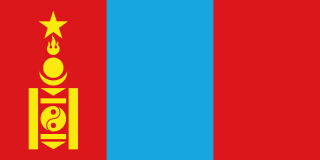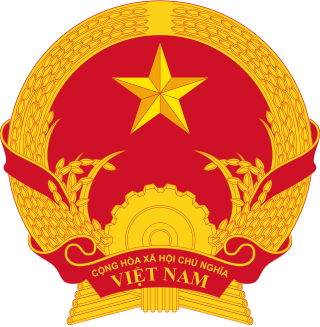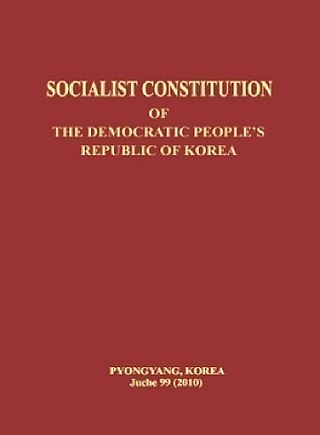 |
|---|
The Mongolian People's Republic had three constitutions, in effect from 1924, 1940, and 1960. [1]
 |
|---|
The Mongolian People's Republic had three constitutions, in effect from 1924, 1940, and 1960. [1]
The first constitution was passed by the First National Great Hural on November 26, 1924. [1] It abolished the monarchical system under Buddhist theocracy and established a people's republic, described the legislative consolidation of state power, provided a basic statement of socioeconomic and political rights and freedoms for the people, and espoused a national program that would bypass the capitalist stage of development in the course of promoting fundamental social transformations in order to bring about socialism in Mongolia. [1]
The second constitution, adopted on June 30, 1940, took the 1936 Soviet Constitution as the model. [1] As Mongolian premier Khorloogiin Choibalsan reported to the Eighth National Great Hural in 1940: "We are guided in our activity by the experience of the great country of socialism, the experience of the Soviet Union. [1] Consequently, only the constitution of the Soviet Union may be a model for us in drafting our new constitution." [1] In subsequent revisions to the 1940 Mongolian constitution in 1944, 1949, 1952, and 1959, disparities between the Mongolian and Soviet constitutions were reduced even further. [1]
Under the 1940 constitution, elections were restricted—"enemies of the regime" could not vote—and indirect; lower bodies elected higher levels. [1] Constitutional amendments introduced after 1944 changed this system, however, by restoring political rights, including the right of suffrage throughout the society; by instituting a unitary hierarchy of directly elected representative bodies; by reorganizing electoral districts; by replacing voting by the show of hands at open meetings with voting by secret ballot; and by abolishing the National Little Hural—the Standing Body of the National Great Hural—transferring its functions to the National Great Hural, which was renamed People's Great Hural in 1951. [1]
The regime's justification for making these changes was that Mongolia had already realized many sociopolitical achievements in its advance toward socialism. [1] Therefore, it became historically correct to introduce reforms that had been adopted in the more advanced society of the Soviet Union. [1]
The third constitution was adopted on July 6, 1960, by the People's Great Hural. [1]
The Constitution adopted in 1960 included a lengthy preamble that acclaims the successes of the revolution and notes the importance of the "fraternal socialist assistance of the Soviet Union" to growth and development in Mongolia. [1] The preamble clarified the dominant role of the Mongolian People's Revolutionary Party as the "guiding and directing force in society," using as its guide the "all-conquering Marxist-Leninist theory." [1] A renewed commitment was made to completing the construction of a socialist society and culture, and eventually, to building a communist society. [1] Enunciated foreign policy goals described a diplomacy based on the principles of peaceful coexistence and proletarian internationalism. [1]
The points outlined in the preamble were explained more fully in the main body of the Constitution. [1] Compared with its 1940 predecessor, the 1960 Constitution was more succinct. [1] The 1940 document had been divided into twelve chapters. [1] The 1960 Constitution clustered most of the same content into four general sections: socioeconomic structure, state structure, basic rights and duties of citizens, and miscellaneous provisions. [1] Within these categories, the articles were compressed into ten chapters, compared with twelve chapters in the 1940 constitution. [1]
In the first general section, the socialist system, rooted in the socialist ownership of national wealth and the means of production, was presented as the economic basis of society. [1] Areas protected under law included private ownership of one's income and savings, housing, subsidiary husbandry, personal and household articles, as well as the right to an inheritance. [1] These legal guarantees, however, were subject to the qualification that "it shall be prohibited to use the right of personal ownership to the detriment of state and social interests." [1]
The second and longest general section defined the state structure, following that laid down in the 1940 constitution, as amended in 1959. [1] It detailed the nature, composition, and duties of all state organs of power, including the executive, the legislative, and the judicial at both the national and local levels. [1]
In the third general section, the fundamental rights and duties of citizens were grouped together, a departure from the previous constitutions. [1] The rights promised in this basic law and the actual experience of Mongolians in daily life, however, were often at variance. [1] Among the basic rights guaranteed were equality irrespective of sex, racial or national affiliations, faith, social origin, and status. [1] These were overlooked in practice, to the extent that male Khalkha Mongols occupied most of the elite government positions, and religious practice was an impediment to career advancement in an atheistic Marxist–Leninist society. [1] In addition, citizens were guaranteed freedom of speech, press, assembly, meeting, demonstration, and processions, but with the restriction that the activities must be practiced "in accordance with the interests of the working people and with a view to developing and strengthening the state system of the Mongolian People's Republic." [1]
A list of duties began with the exhortation that "every citizen of the Mongolian People's Republic shall be obliged to: show dedication to the cause of building socialism; maintain the priority of the interests of society and the state vis-à-vis private interests; safeguard the concept of communal socialist property; and fulfill all civic duties, and demand the same of other citizens." [1] Other duties involved supporting international friendship and worker solidarity "under the leadership of the Soviet Union," and teaching and practicing good social values. [1]
The Constitution could be amended by the People's Great Hural with a majority of not less than two-thirds of the delegate votes, a system that produced frequent revision. [1] Perhaps the most novel feature of the Constitution was contained in its concluding article, unique among socialist constitutions. [1] Article 94 allowed the gradual repeal of the constitutional provisions: "The Constitution . . . will be repealed when the need for the existence of the state, which is the principal instrument for building socialism and communism, disappears, when it will be replaced by a communist association of working people." [1]

The Constitution of the People's Republic of China is the supreme law of the People's Republic of China. It was adopted by the 5th National People's Congress on December 4, 1982, with further revisions about every five years. It is the fourth constitution in PRC history, superseding the 1954 constitution, the 1975 constitution, and the 1978 constitution.

A communist state, also known as a Marxist–Leninist state, is a one-party state that is administered and governed by a communist party guided by Marxism–Leninism. Marxism–Leninism was the state ideology of the Soviet Union, the Comintern after Bolshevisation and the communist states within the Comecon, the Eastern Bloc, and the Warsaw Pact. Marxism–Leninism currently still remains the ideology of a few parties around the world. After its peak when many communist states were established, the Revolutions of 1989 brought down most of the communist states, however, it is still the official ideology of the ruling parties of China, Cuba, Laos, Vietnam, and to a lesser extent, North Korea. During most of the 20th century, before the Revolutions of 1989, around one-third of the world's population lived under communist states.

The Constitution of East Germany refers to the constitution of the German Democratic Republic, commonly known as East Germany. Its original constitution was promulgated on 7 October 1949. It was heavily based on the "Weimarer Reichsverfassung", and nominally established the GDR as a liberal democratic republic. In 1968 the East German government adopted a new, fully Communist constitution that was based on Marxism-Leninism, political unitarism, and collective leadership. There were further amendments to the 1968 constitution in 1974. With the political events of 1989, there were attempts to draft a new constitution for East Germany, but these efforts never materialized due to the dissolution of East Germany and the accession of its Länder into the neighboring Federal Republic.

The Mongolian People's Republic was a socialist state which existed from 1924 to 1992, located in the historical region of Outer Mongolia in East Asia. For nearly all of its existence, it was a one-party state ruled by the Mongolian People's Revolutionary Party, and maintained close ties with the Soviet Union. Socialist collectivization, industrialization, and urbanization transformed Mongolia's agrarian, nomadic economy of the 1920s into a developing, agricultural-industrial economy by the late 1980s.

During its existence, the Soviet Union had three different constitutions enforced individually at different times between 31 January 1924 to 26 December 1991.
The 1936 Constitution of the Soviet Union, also known as the Stalin Constitution, was the constitution of the Soviet Union adopted on 5 December 1936.
The 1977 Constitution of the Soviet Union, officially the Constitution of the Union of Soviet Socialist Republics, was the constitution of the Soviet Union adopted on 7 October 1977.

The Constitution of the Czechoslovak Socialist Republic, promulgated on 11 July 1960 as the constitutional law 100/1960 Sb., was the third constitution of Czechoslovakia, and the second of the Communist era. It replaced the 1948 Ninth-of-May Constitution and was widely changed by the Constitutional Law of Federation in 1968. It was extensively revised after the Velvet Revolution to prune out its Communist character, with a view toward replacing it with a completely new constitution. However, this never took place, and it remained in force until the dissolution of Czechoslovakia in 1992.

The Constitution of the Socialist Republic of Vietnam is the current constitution of Vietnam, adopted on November 28, 2013, by the Thirteenth National Assembly, and took effect on January 1, 2014. It is the fourth constitution adopted by the Vietnamese government since the political reunification of the country in 1976.

The State Great Khural is the unicameral parliament of Mongolia. It is located in the Government Palace.

The Socialist Constitution of the Democratic People's Republic of Korea is the constitution of North Korea. It was approved by the 6th Supreme People's Assembly at its first session on 27 December 1972, and has been amended and supplemented in 1998, 2009, 2012, 2013, 2016 and twice in 2019. It replaced the country's first constitution which was approved in 1948.

The Constitution of Latvia is the fundamental law of the Republic of Latvia. Satversme is the oldest Eastern or Central European constitution still in force and the sixth oldest still-functioning republican basic law in the world. It was adopted, as it states itself in the text, by the people of Latvia, as represented in the Constitutional Assembly of Latvia, on 15 February 1922 and came into force on 7 November 1922. It was heavily influenced by Germany's Weimar Constitution and the Swiss Federal Constitution. The constitution establishes the main bodies of government ; it consists of 116 articles arranged in eight chapters.

The Preamble to the Constitution of India presents the principles of the Constitution and indicates the sources of its authority. It was adopted on 26 November 1949 by the Constituent Assembly and came into effect on 26 January 1950, celebrated as the Republic Day of India. It was amended during the Indian emergency by Indira Gandhi where the words "socialist" and "secular" were added.

The Constitution of Laos specifies the functions and powers of the government of the Lao People's Democratic Republic, and defines the rights and duties of Laotian citizens. The constitution was adopted on August 14, 1991, sixteen years after the 1975 establishment of the Republic, a period during which the country functioned without a written constitution or published penal and criminal codes. It consists of a Preamble and Articles, and legally establishes a set of authorities that resemble the traditional differentiation among executive, legislative, and judicial branches of government.

Administrative law in Mongolia is the body of law that governs the activities of administrative agencies of the Mongolian government. These activities include rulemaking, adjudication, or the enforcement of a specific regulatory agenda.
The Hungarian Constitution of 1949 was adopted on 20 August 1949 and heavily amended on 23 October 1989. The document was Hungary's first permanent written constitution, and until its replacement in 2011, the country was the only former Eastern Bloc nation that did not adopt an entirely new constitution after the fall of Communism. The Constitution of Hungary, adopted in 2011, declares the 1949 constitution to be invalid.
The Ukrainian Soviet Socialist Republic, part of the Soviet Union, had four successive constitutions during its existence. The first (1919) was in Russian and the final three were in Ukrainian.
A socialist state, socialist republic, or socialist country, sometimes referred to as a workers' state or workers' republic, is a sovereign state constitutionally dedicated to the establishment of socialism. The term communist state is often used synonymously in the West, specifically when referring to one-party socialist states governed by Marxist–Leninist communist parties, despite these countries being officially socialist states in the process of building socialism and progressing toward a communist society. These countries never describe themselves as communist nor as having implemented a communist society. Additionally, a number of countries that are multi-party capitalist states make references to socialism in their constitutions, in most cases alluding to the building of a socialist society, naming socialism, claiming to be a socialist state, or including the term people's republic or socialist republic in their country's full name, although this does not necessarily reflect the structure and development paths of these countries' political and economic systems. Currently, these countries include Algeria, Bangladesh, Guyana, India, Nepal, Nicaragua, Sri Lanka and Tanzania.
Socialism has been mentioned in several liberal democratic constitutions. It is referenced either in the form of denunciation or in form of construction, namely that the constitution of the state in question proclaim that it seeks to establish a socialist society. In these cases, the intended meaning of the term socialism can vary widely and sometimes the constitutional references to socialism are left over from a previous period in the country's history.
{{cite encyclopedia}}: CS1 maint: postscript (link)